Lish Gates, Director of Global Revenue Enablement at Algolia, gave this talk at the Sales Enablement Festival in October 2020.
In this article, I’ll dive into the world of artificial intelligence, attempt to demystify it, and share a few AI tools for enablement.
I’ll explain why applying a human approach to AI is key, and share two case studies to highlight why a human approach to AI and automation will lead to the most powerful results.
I'm Lish Gates and I currently lead the global revenue enablement team at Algolia. We are a search as a service platform that specializes in understanding users’ intent through web, app, and voice.
We provide tools to business users and developers to create a frictionless search and discovery experience. A lot of this is powered by artificial intelligence.
Ahead of building the enablement function at Algolia, I was formerly the Director of Sales Operations for IHeartMedia's local market groups. There, I had amazing opportunities to solve problems using technology like digital robotics to programmatically remove human error from order entry at scale for over 850 radio stations.
It's safe to say I am thrilled I get to share some thoughts around AI and automation. It's a space I'm very passionate about and to give you a few ideas and tactics that you can leverage in the enablement space.
The world has changed
I'm going to state the obvious - the world has changed. 74% of companies are shifting to remote first per review42.com and there's a 46% expected growth of enablement teams in the next 12 months.
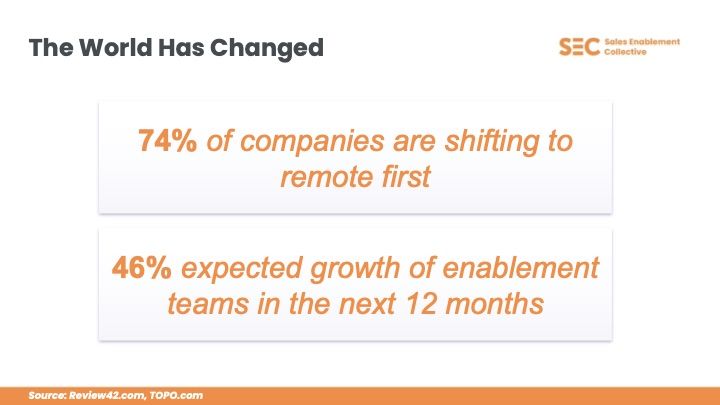
With that said, I think it's very safe to say companies are investing in a lot of technology to make sure we stay connected and productive.
They're using AI and automation to do so.
What is artificial intelligence?
It's really fun because you can talk to a lot of different people and it means a lot of different things. If I talk to my parents, they probably think of the Terminator.
If I talk to anyone that's been watching Netflix recently, which is basically everyone, they've been watching the Social Dilemma, and they think AI is controlling us.

But for sales ops or a sales enablement professional, they think it means, "awesome, we get to do all of the things, we get all of this analytics and data to make ourselves better at our jobs and to help our reps be more productive".
Some reps when I speak to them, they're like, "Great, I just get to push this button and lay right back".
So it's quite a buzzword, it can mean a lot of different things. I'm going to demystify it a little bit and just boil it down to the fact we're basically using it to make computers perform human tasks.
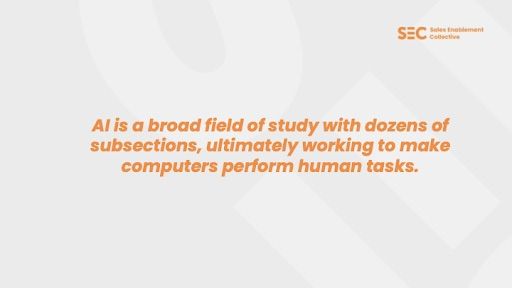
I'm going to give a couple of ideas of how it's done.
Demystifying artificial intelligence
Machine learning
Artificial intelligence involves machine learning, things like deep learning, predictive analytics, and something that might be more familiar for you in the space of the Netflix recommendation engine.
Based upon what you browse, what you search for, what you watch, what people like you watch, you'll be recommended movies or TV shows.
Speech & text
Another example of AI is speech and text. Things like natural language understanding, natural language processing, natural language generation. A really good example of this is Amazon's Alexa or Apple Siri.
Vision
The last example I'm going to talk about today is vision and that is computer vision and image recognition. A really good example of this is autonomous driving cars or vehicles.
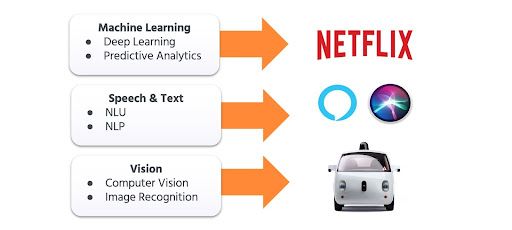
There are lots of other spaces under AI, it's a big umbrella of things. There are things like robotics and rule-based AI decision trees, etc.
A few AI tools for enablement
When I was looking at creating this article and where to drill into it, I realized, man, there's so much AI technology in the sales ops and sales enablement space to make a more productive environment for our reps.
These are just a few of the logos that can help us do it.
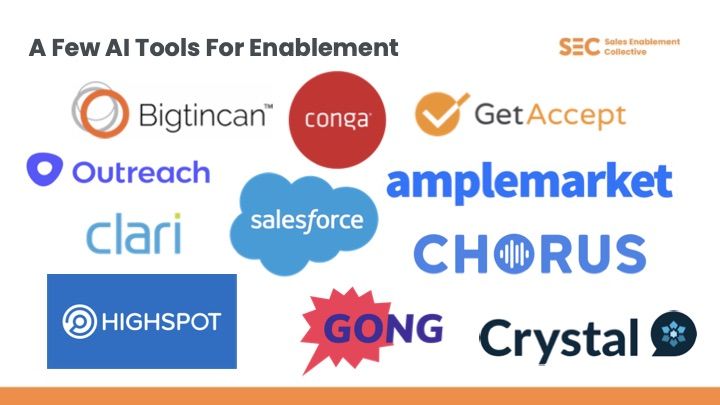
But why does human intervention matter?
Why does human intervention matter when we have all of this amazing technology?
When I was building this article, I could really boil it down to just one word, and that one word was context.
What do I mean by context?
In today's tooling in the enablement space, there are a few things that I can absolutely confirm. Some of these are probably great ideas for product roadmaps for some of these companies that use AI.
AI doesn’t know our competitors (yet)
They don't know who our competitors are yet so when I bought a tool in the space, I had to tell it what our competitors were.
AI doesn’t know what deals are winning and why (yet)
And it doesn't know what deals we're winning and specifically why. Because we all have so many different ways of selling and what good can look like.
There are so many different styles out there. There are so many different messages and ways to resonate with a buyer and a consumer.
AI doesn’t know executive mandates and company priorities
The very last thing is that AI doesn't know the ever-changing mandates and company priorities. That needs a human to provide that context and to use these tools in that way.
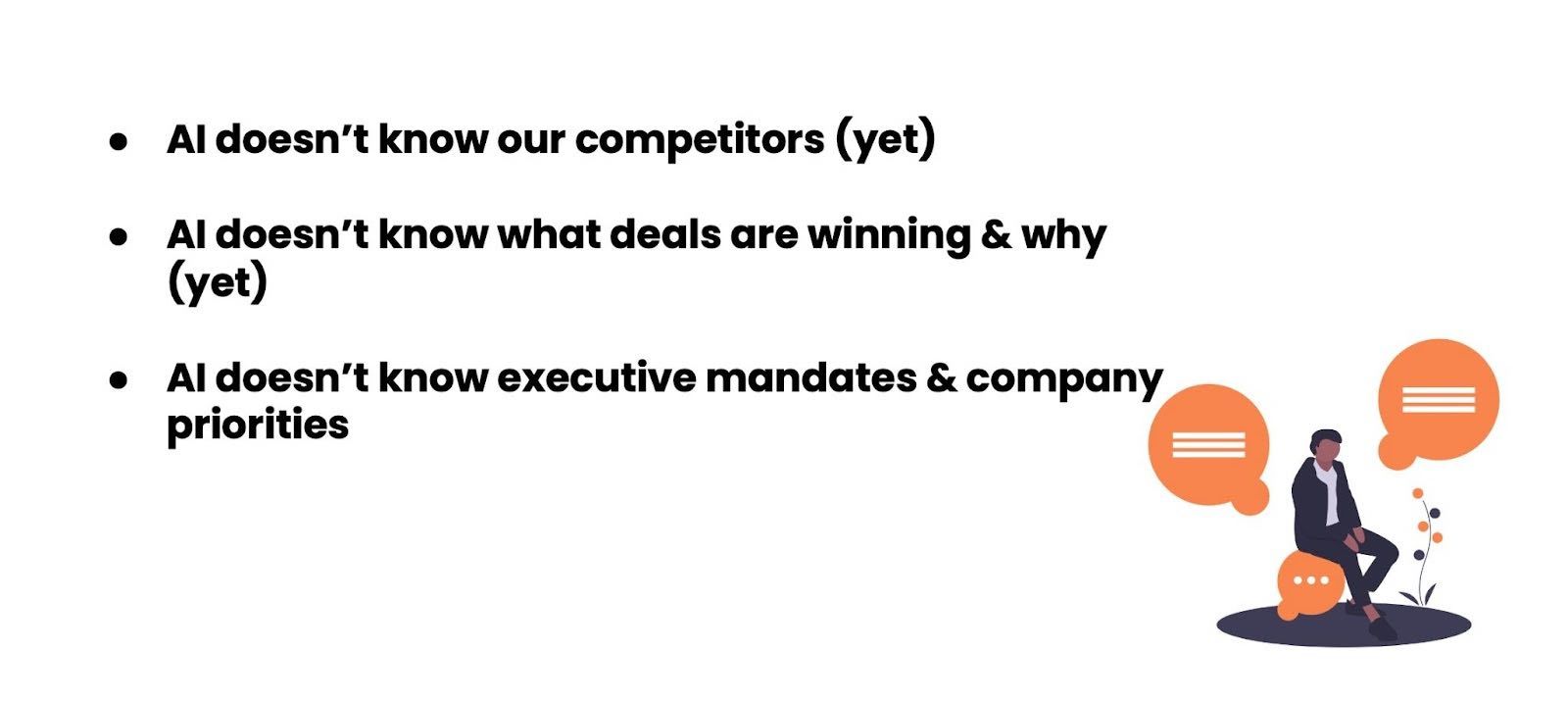
In this article, I'm going to cover a couple of examples of how I've been applying the human approach to some of the AI technology out there, and hopefully give you guys some great ideas to walk away with.
Applying a human approach to some AI technology
Case study 1
The first case study I'm going to go into is the situation where we had a problem where knowledge of best practices was siloed. We have two teams, they're globally spread apart, half of them are in EMEA, and half of them are in the US.
We needed to create an environment where we could foster coaching and upskilling our reps and we needed to also understand when we were doing that we were actually impacting the customer and the prospect interactions.
There was the issue of yes, we could just record our calls on Zoom or whatever tool you're using in the space and spend hours watching this and trying to understand what was happening. But the reality is, we need a faster way to do this so that we could help faster.
Conversational intelligence software
So we looked to conversational intelligence software, and there are a few in the space like Chorus and Gong.
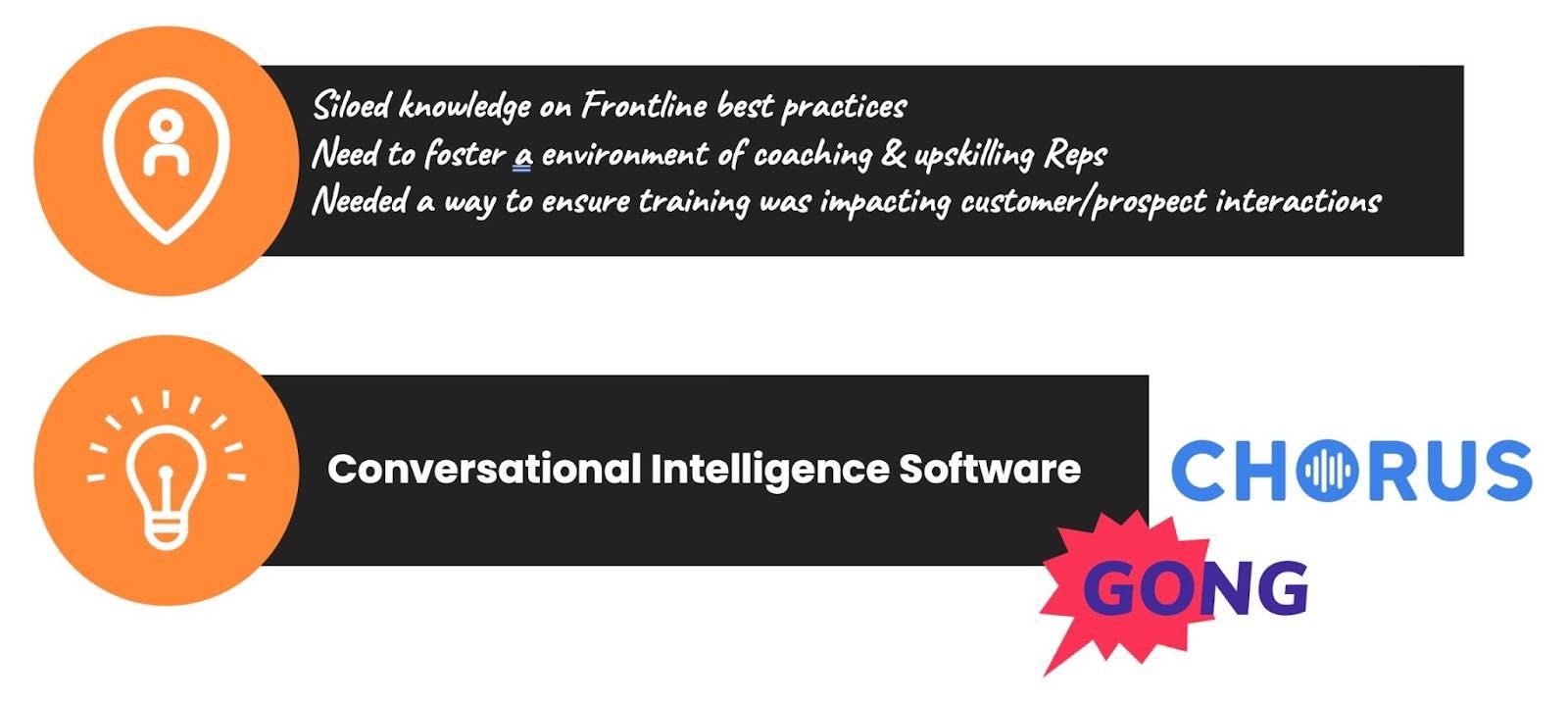
What these technologies do is understand your reps voice versus a prospect or a customer's voice and they're able to transcribe the entire conversation.
You're able to give the tool context by adding trackers around competitor names, specific value messaging, product and features, you name it, you can literally add any tracking you want in the world and it will add that tracker into being searchable across all of the calls it's recording.
Getting started…
There are so many ways to build a wonderful business case of why to use this kind of technology. I'm just going to go through a couple of different departments and how I was able to provide a way for this tool to be leveraged by them.
What these technologies do is understand your reps voice versus a prospect or a customer's voice and they're able to transcribe the entire conversation.
- Reps
The first one is obviously our reps, SEs, STIs, CSMs, we shared this tool with them as a productivity tool. It's their note-taker, it connects to our CRM, it updates next steps on deals.
We use it also to obviously share best practices that siloed knowledge that we were trying so hard to capture, and used it as a positive reinforcement tool. We saw things that were really good, we shared it with the world.
The number one thing that was important with this tool was not to use it as a policing tool, that "Aha gotcha". That was really, really important.
- Managers
The next piece was getting managers on board. Sharing valuable insights with leadership was the best way to sell this tool internally to them, and get them adopted.
When you're able to come out with "Hey, you wouldn't believe what I've learned from watching 90 calls in Chorus over the last 90 days" they were definitely ears perked up, listening.
They were able to get on board, they started wanting to get their own insights and that was a really easy way to get them adopted and into the tool.
- Product
Product was able to get instant feedback loops from prospects and customers. This was really helpful for them to identify where potential gaps were, and also how they could change their roadmap as a result.
- Marketing
Marketing was able to garner top competitors being mentioned by prospects, features that were getting mentioned the most in our calls, and also insight into if the messaging they're providing is actually resonating with the consumer.
- Execs
For executive leadership, we were able to bring them up to speed faster and provide context to deals they would be joining on the next call as an executive sponsor.
They would listen to the calls we'd had beforehand so they weren't having to make the customer repeat themselves as they were joining the call.
- Engineering
The very last one is engineering. Engineering was able to get a little bit more conviction around what they're building and why because they're able to hear from the prospects and the customers the problem they're solving for them.
Building impactful programs
The next stage after you've got everyone on board, and everyone rallied around the tool, is to build impactful programs.
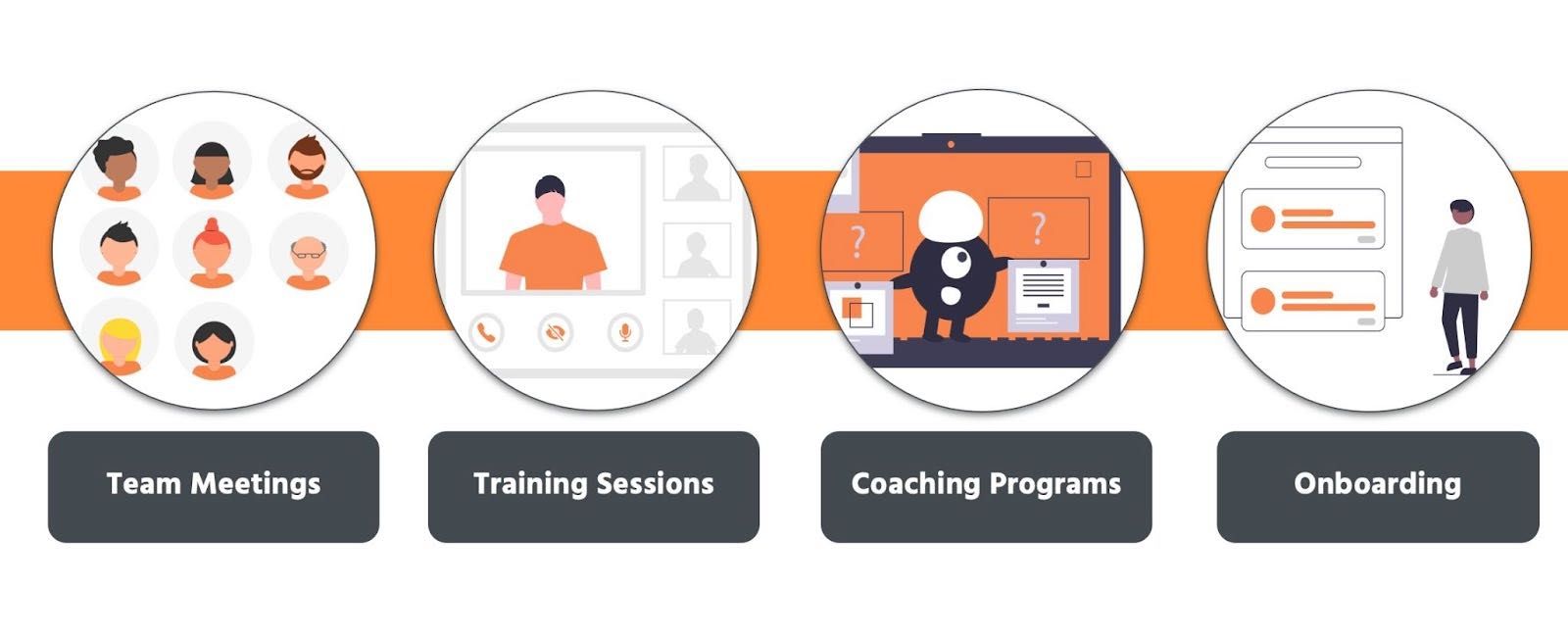
There are a few ways to do that, team meetings, training sessions, coaching programs, and onboarding are just a couple. I'm going to share a couple of ideas.
Team meetings
- Objection handling scenarios
We joined the role meetings and the team huddles, and we would do objection handling scenarios. We would take a clip of a prospect asking a question, we'd pause the video, and then we would have a round table of answers from each rep with how they would have answered it.
It's really insightful to see how they respond and then we can play what actually happened.
- Wow moments
The other thing we do is share wow moments. We would play the moment, and ask the reps, what did you like? What would you do differently?
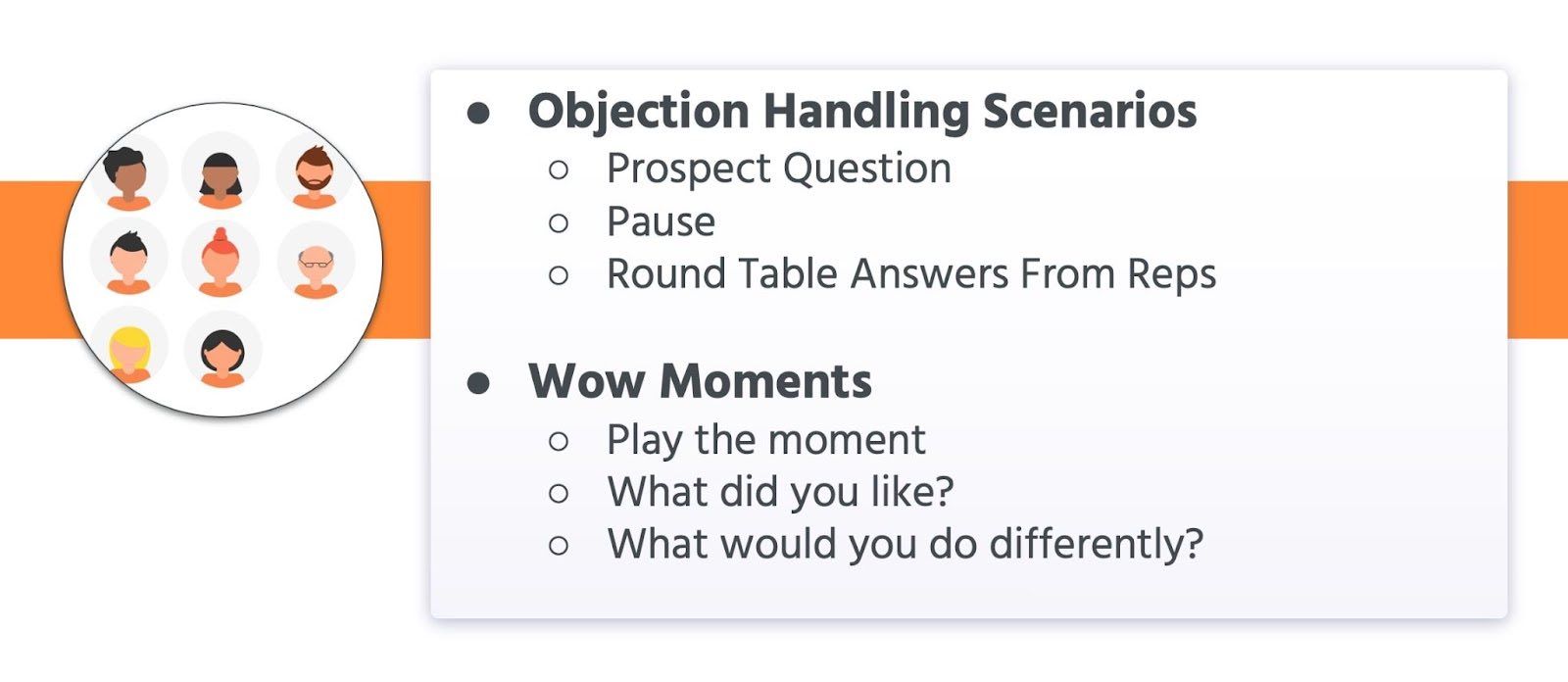
Training sessions
For our larger training sessions, we would leverage clips from cold and gamify them.
- Is this a champion?
Recently, we've been practicing our methodology, we were going over what really makes a champion, and we would play this game called 'is this a champion?'.
We play a clip of a prospect or customer and we would poll the team, is this a champion? Yes or no? We would question each team’s answers with what their reasoning was. If they were team yes, then what were the characteristics you saw to make you think that way? And vice versa for the opposing team.
- What’s the solution?
Another way we would do this is 'what's the solution?'. We would find a clip from Chorus or from Gong and play a clip of the prospect’s pains, break the reps into small groups, and get them to practice how they would demo and pitch as a result of that.
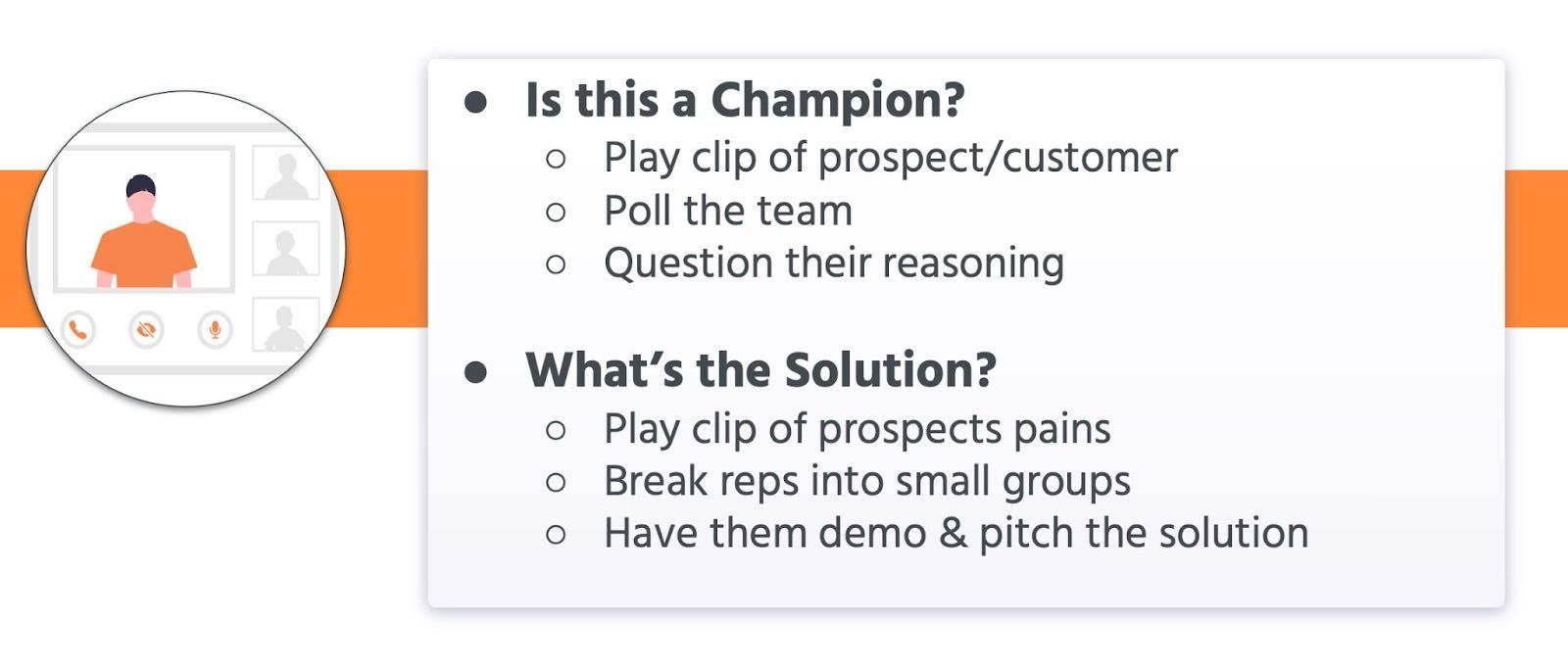
Coaching programs
My favorite story to date is the coaching programs that we've been able to come up with.
We have leveraged the insights we can see in our CRM, in this specific scenario, we were looking at conversion by stage and realizing we have a lot of work to do at top of the funnel.
- Scorecards and 1:1 coaching
As you're doing a root analysis of that problem, what's causing that conversion to be so low we were able to look into conversational intelligence tools at calls that were happening at that stage and come up with a few theories as to why.
Then we would partner with our sales leadership team and we came up with five things we were able to boil it down to. Things we wanted to improve, and we coggled a scoring rubric for those five things.
The next step was to agree on how many scorecards they would fill out every single week for the entire quarter. We've been watching and tracking those metrics for improvement.
There has been a really great report, the state of conversational intelligence report and in this report, it shares that when coaching happens at the top end of the funnel, on those early-stage deals, there can be a 30% improvement in your win rate.
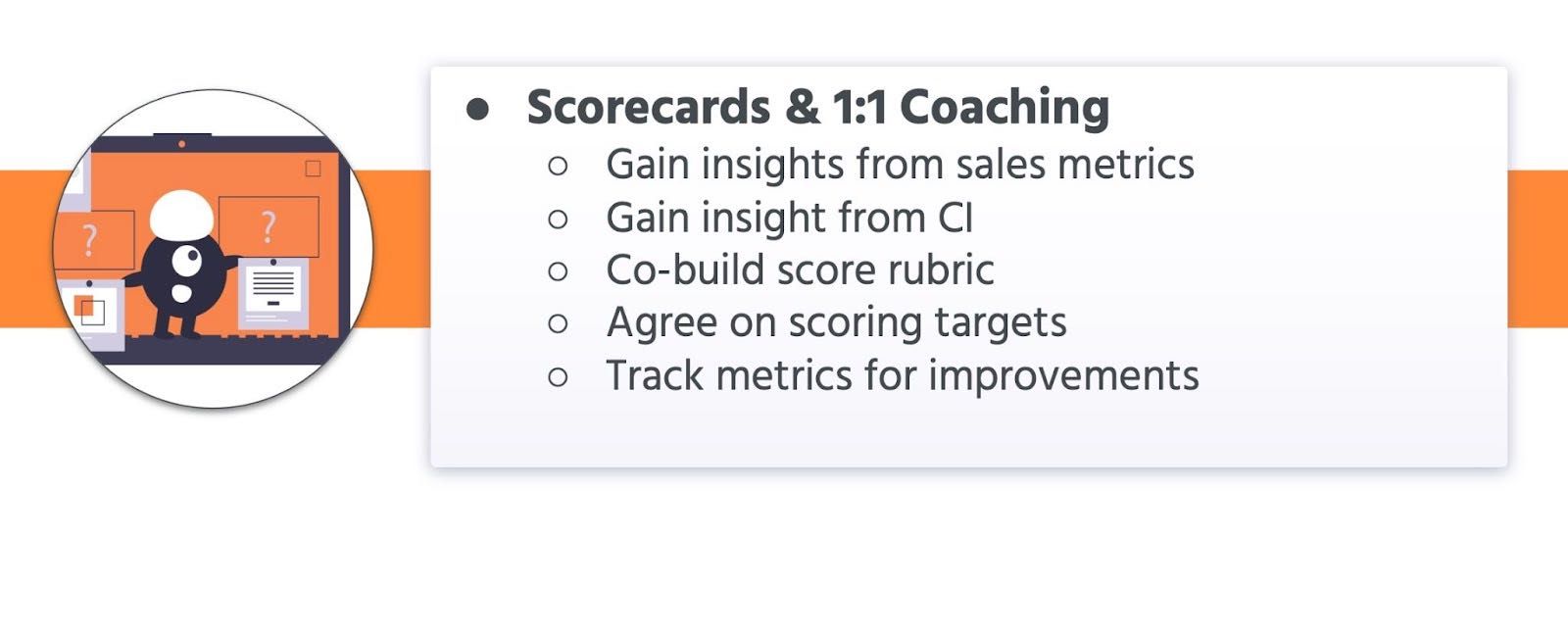
Onboarding playlists
The last one that I want to share is onboarding playlists. Onboarding playlists are great.
For our larger training sessions, we would leverage clips from cold and gamify them.
- Shadowing on demand
We used to have to shadow in real life and the problem with shadowing in real life is you don't know if it's going to be the best call for them to shadow.
A conversational intelligence tool takes that guesswork away. We're able to build the best of the best buy-deal stages and embed those into our onboarding program.
We're also able to build best practices by revenue roles and fit those into everyone's onboarding program.
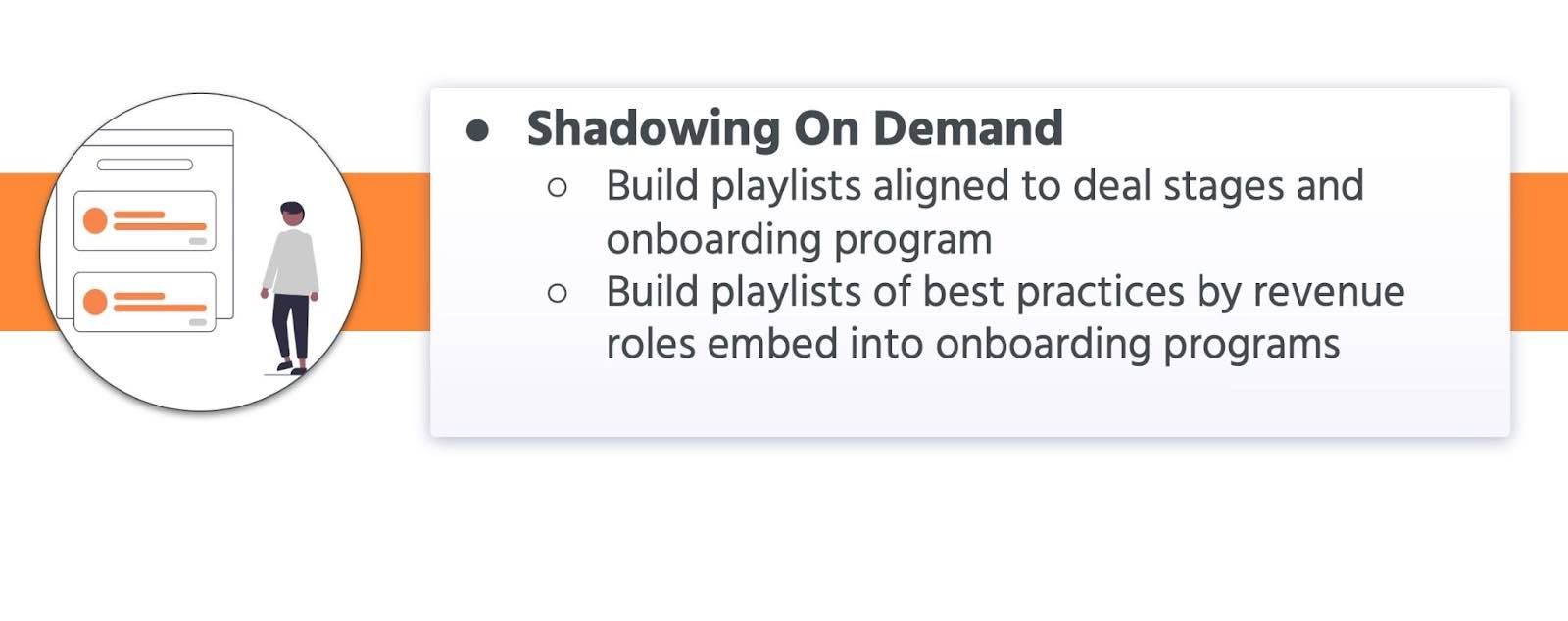
Creating a culture
The most important thing when you're rolling out anything is to create a culture around it. One of the ways we did that at Algolia was we created a Slack channel.
We called it the Sales Hotline Bling and it's where we share wow moments every week and every day in some cases of best practices we see on the frontlines from watching Chorus calls.
We're currently gearing up for our first-ever virtual kickoff and we're planning on doing an Al Golden Globe Award ceremony, where we will have wow moments that are nominated in different categories.
Obviously, we'll have a big vote of who has won those nominations. I think it's safe to say when you have a rep asking for their weight in call wow moments that we have sufficiently created a culture for it.
All of that human context and adoption is what makes us a powerful tool and enablement is the link of driving this.
AI experiences we love...
AI is responsible for powering the most amazing personalized experiences. There are Netflix recommendation engines, our playlist on Spotify, Amazon's always prescribing the best things we want to buy as a result of what we've bought before.
Automated experiences we don’t...
But on the flip side, there are automated experiences we don't always love. It's happened to all of us. Automation at scale means potentially sacrificing personalization.
Here's an example of my spam inbox from a few days ago, and unfortunately, I have been the victim of un-personalized messages.
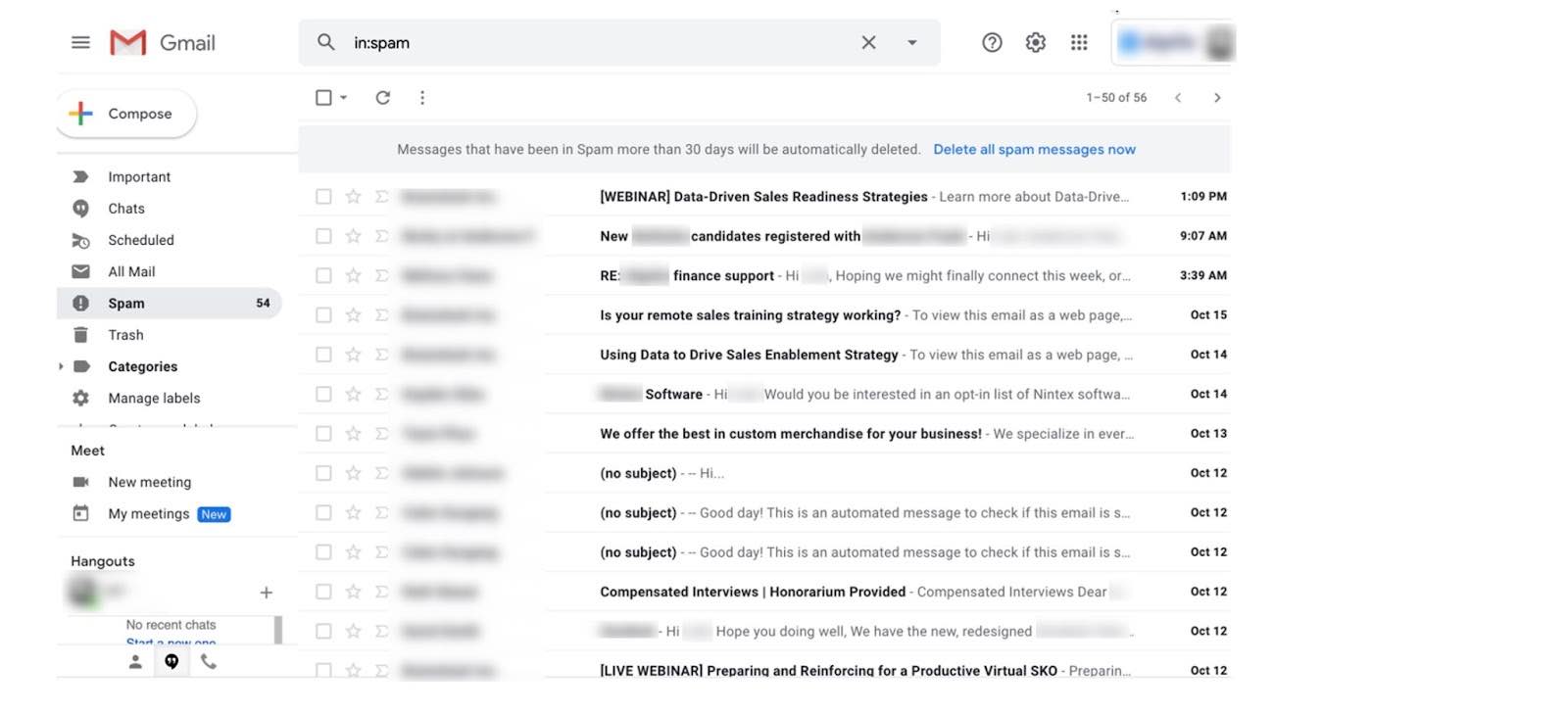
Let's talk about applying a human approach to automation.
Case Study 2
Unfortunately, as you can see, spray and pray, sadly exists more than we would like to admit. The result and the solution is we have to use our humanity to remind people there's a real-life human that responds to that inbox.
We have to do empathy training, and we have to be curious, and we have to create frameworks that can help do that. I always say to our reps if content is king, context is God, there's a reason why they're not on the end of a marketing automation tool, or on the marketing team sending out that blast to everyone.
There's a reason why they have this amazing role where they get to create context for other humans.
The 5x5x5 framework
We use the 5x5x5 framework.
Five minutes of research, five key insights they find as a result of that five minutes of research, and then they spend five minutes for the email.
Each email and the cadence they're building should only be focused on one of those insights.
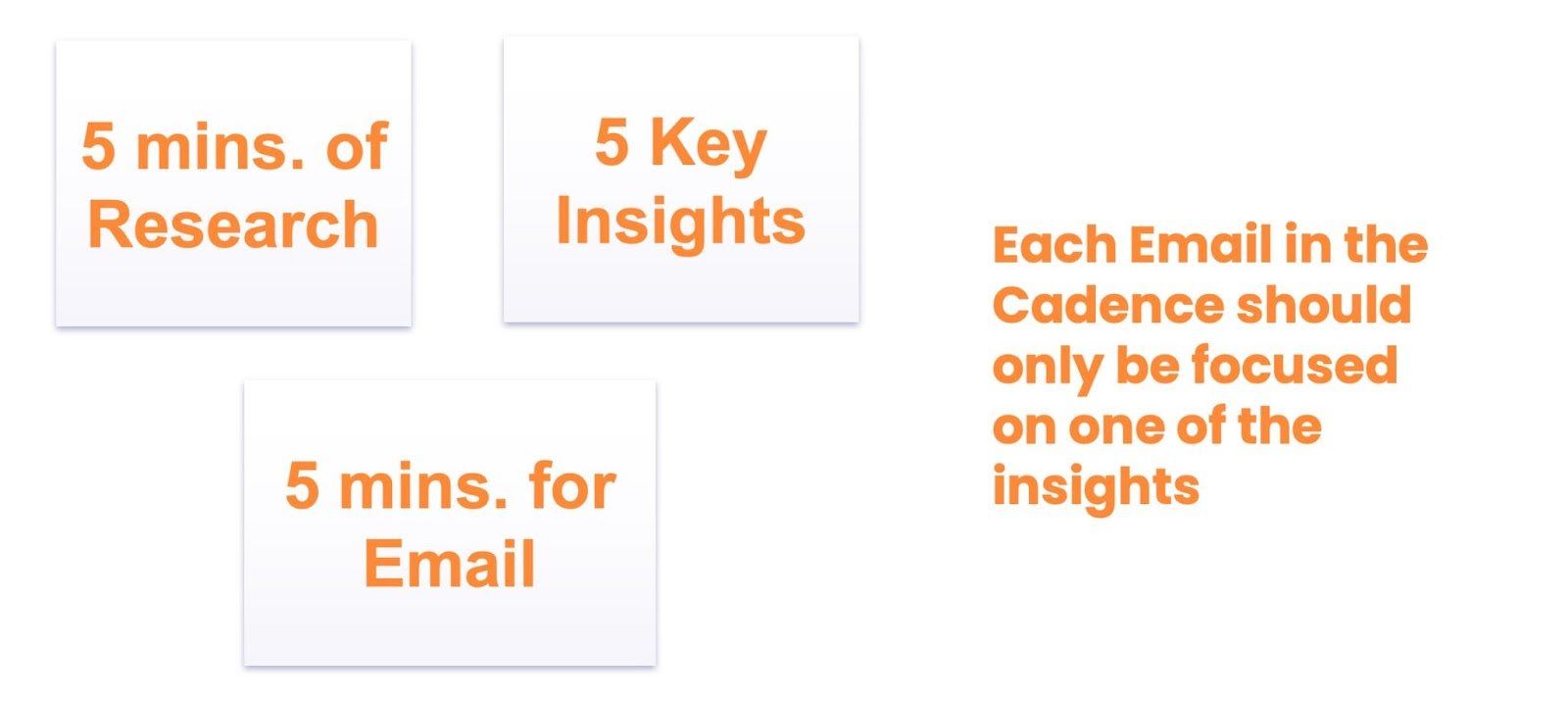
The 10-80-10 rule
When they're actually writing an email, we try to use the 10-80-10 rule. It's 10% personalization at the top, they can use that message we get from marketing, and 10% of personalization at the bottom.
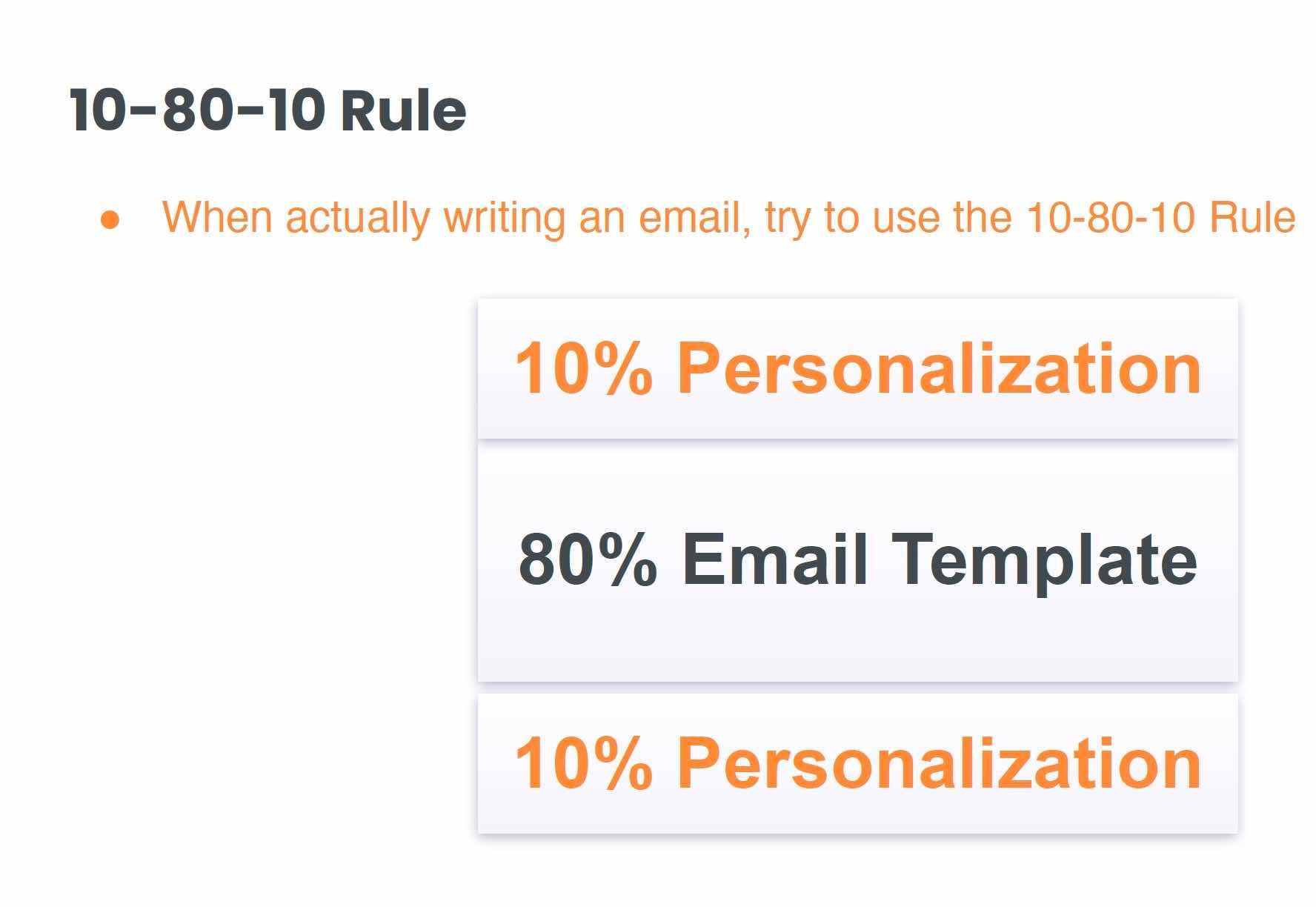
Facts...
But the truth is personalization works and this is a phenomenal graph from Peter Sazanjy, he wrote a book called Founding Sales.
This graph really shows this.
We have done one where there's absolutely no personalization done at all.
There's no personalization and a drip to light auto personalization, heavy auto personalization, and an actual human personalization where we're providing that context.
You can see in the total results, it doesn't even compare.
People learn from emotion and people buy through emotion. That requires us to be human.
That is why I have a very strong conviction around AI and automation, and it requiring that human intervention to provide context.
Thank you.



